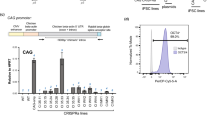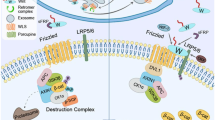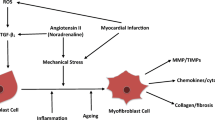Abstract
Human pluripotent stem cell (hPSC)-derived cardiomyocytes hold great potential for in vitro modeling of diseases like cardiomyopathies. Yet, knowledge about expression and functional impact of sarcomeric protein isoforms like the myosin heavy chain (MyHC) in hPSC-cardiomyocytes is scarce. We hypothesized that ventricular β-MyHC expression alters contraction and calcium kinetics and drives morphological and electrophysiological differentiation towards ventricular-like cardiomyocytes. To address this, we (1) generated human embryonic stem cell-derived cardiomyocytes (hESC-CMs) that switched towards exclusive β-MyHC, and (2) functionally and morphologically characterized these hESC-CMs at the single-cell level. MyHC-isoforms and functional properties were investigated during prolonged in vitro culture of cardiomyocytes in floating cardiac bodies (soft conditions) vs. culture on a stiff matrix. Using a specific anti-β-MyHC and a newly generated anti-α-MyHC-antibody, we found individual cardiomyocytes grown in cardiac bodies to mostly express both α- and β-MyHC-protein isoforms. Yet, 35 and 75 days of cultivation on laminin-coated glass switched 66 and 87 % of all cardiomyocytes to exclusively express β-MyHC, respectively. Twitch contraction and calcium transients were faster for CMs on laminin-glass. Surprisingly, both parameters were only little affected by the MyHC-isoform, although hESC-CMs with only β-MyHC had much lower ATP-turnover and tension cost, just as in human ventricular cardiomyocytes. Spontaneous contractions and no strict coupling of β-MyHC to ventricular-like action potentials suggest that MyHC-isoform expression does not fully determine the hESC-CM differentiation status. Stiff substrate-induced pure β-MyHC-protein expression in hESC-CMs, with several contractile parameters close to ventricular cardiomyocytes, provides a well-defined in vitro system for modeling of cardiomyopathies and drug screening approaches.







Similar content being viewed by others
References
Berry MF, Engler AJ, Woo YJ, Pirolli TJ, Bish LT, Jayasankar V, Morine KJ, Gardner TJ, Discher DE, Sweeney HL (2006) Mesenchymal stem cell injection after myocardial infarction improves myocardial compliance. Am J Physiol Heart Circ Physiol 290:H2196–H2203. doi:10.1152/ajpheart.01017.2005
Beuckelmann DJ, Nabauer M, Erdmann E (1992) Intracellular calcium handling in isolated ventricular myocytes from patients with terminal heart failure. Circulation 85:1046–1055. doi:10.1161/01.CIR.85.3.1046
Brenner B (1988) Effect of Ca2+ on cross-bridge turnover kinetics in skinned single rabbit psoas fibers: implications for regulation of muscle contraction. Proc Natl Acad Sci USA 85:3265–3269 (PMCID: PMC280185)
Chopra A, Tabdanov E, Patel H, Janmey PA, Kresh JY (2011) Cardiac myocyte remodeling mediated by N-cadherin-dependent mechanosensing. Am J Physiol Heart Circ Physiol 300:H1252–H1266. doi:10.1152/ajpheart.00515.2010
Ebrecht G, Rupp H, Jacob R (1982) Alterations of mechanical parameters in chemically skinned preparations of rat myocardium as a function of isoenzyme pattern of myosin. Basic Res Cardiol 77:220–234. doi:10.1007/BF01908175
Gorza L, Mercadier JJ, Schwartz K, Thornell LE, Sartore S, Schiaffino S (1984) Myosin types in the human heart. An immunofluorescence study of normal and hypertrophied atrial and ventricular myocardium. Circ Res 54:694–702. doi:10.1161/01.RES.54.6.694
Hodgkinson CP, Kang MH, Dal-Pra S, Mirotsou M, Dzau VJ (2015) MicroRNAs and Cardiac Regeneration. Circ Res 116:1700–1711. doi:10.1161/CIRCRESAHA.116.304377
Kempf H, Olmer R, Kropp C, Ruckert M, Jara-Avaca M, Robles-Diaz D, Franke A, Elliott DA, Wojciechowski D, Fischer M, Roa Lara A, Kensah G, Gruh I, Haverich A, Martin U, Zweigerdt R (2014) Controlling expansion and cardiomyogenic differentiation of human pluripotent stem cells in scalable suspension culture. Stem Cell Rep 3:1132–1146. doi:10.1016/j.stemcr.2014.09.017
Kraft T, Paalberends ER, Boontje N, Tripathi S, Brandis A, Montag J, Hodgkinson JL, Francino A, Navarro-Lopez F, Brenner B, Stienen G, van der Velden J (2013) Familial Hypertrophic Cardiomyopathy: functional effects of myosin mutation R723G in cardiomyocytes. J Mol Cell Cardiol 57:13–22. doi:10.1016/j.yjmcc.2013.01.001
Lan F, Lee AS, Liang P, Sanchez-Freire V, Nguyen PK, Wang L, Han L, Yen M, Wang Y, Sun N, Abilez OJ, Hu S, Ebert AD, Navarrete EG, Simmons CS, Wheeler M, Pruitt B, Lewis R, Yamaguchi Y, Ashley EA, Bers DM, Robbins RC, Longaker MT, Wu JC (2013) Abnormal calcium handling properties underlie familial hypertrophic cardiomyopathy pathology in patient-specific induced pluripotent stem cells. Cell Stem Cell 12:101–113. doi:10.1016/j.stem.2012.10.010
Li M, Iismaa SE, Naqvi N, Nicks A, Husain A, Graham RM (2014) Thyroid hormone action in postnatal heart development. Stem Cell Res 13:582–591. doi:10.1016/j.scr.2014.07.001
Li S, Chen G, Li RA (2013) Calcium signalling of human pluripotent stem cell-derived cardiomyocytes. J Physiol 591:5279–5290. doi:10.1113/jphysiol.2013.256495
Linke WA (2008) Sense and stretchability: the role of titin and titin-associated proteins in myocardial stress-sensing and mechanical dysfunction. Cardiovasc Res 77:637–648. doi:10.1016/j.cardiores.2007.03.029
Liu N, Olson EN (2010) MicroRNA regulatory networks in cardiovascular development. Dev Cell 18:510–525. doi:10.1016/j.devcel.2010.03.010
Lundy SD, Zhu WZ, Regnier M, Laflamme MA (2013) Structural and functional maturation of cardiomyocytes derived from human pluripotent stem cells. Stem Cells Dev 22:1991–2002. doi:10.1089/scd.2012.0490
Mahaffy RE, Shih CK, MacKintosh FC, Kas J (2000) Scanning probe-based frequency-dependent microrheology of polymer gels and biological cells. Phys Rev Lett 85:880–883. doi:10.1103/PhysRevLett.85.880
Maron BJ, Maron MS (2013) Hypertrophic cardiomyopathy. Lancet 381:242–255. doi:10.1016/S0140-6736(12)60397-3
McDevitt TC, Laflamme MA, Murry CE (2005) Proliferation of cardiomyocytes derived from human embryonic stem cells is mediated via the IGF/PI 3-kinase/Akt signaling pathway. J Mol Cell Cardiol 39:865–873. doi:10.1016/j.yjmcc.2005.09.007
Miyata S, Minobe W, Bristow MR, Leinwand LA (2000) Myosin heavy chain isoform expression in the failing and nonfailing human heart. Circ Res 86:386–390. doi:10.1161/01.RES.86.4.386
Molkentin JD, Lu JR, Antos CL, Markham B, Richardson J, Robbins J, Grant SR, Olson EN (1998) A calcineurin-dependent transcriptional pathway for cardiac hypertrophy. Cell 93:215–228. doi:10.1016/S0092-8674(00)81573-1
Mutig N, Geers-Knoerr C, Piep B, Pahuja A, Vogt PM, Brenner B, Niederbichler AD, Kraft T (2013) Lipoteichoic acid from Staphylococcus aureus directly affects cardiomyocyte contractility and calcium transients. Mol Immunol 56:720–728. doi:10.1016/j.molimm.2013.07.007
Poggesi C, Tesi C, Stehle R (2005) Sarcomeric determinants of striated muscle relaxation kinetics. Pflug Arch 449:505–517. doi:10.1007/s00424-004-1363-5
Price KM, Littler WA, Cummins P (1980) Human atrial and ventricular myosin light-chains subunits in the adult and during development. Biochem J 191:571–580. doi:10.1042/bj1910571
Ribeiro AJ, Ang YS, Fu JD, Rivas RN, Mohamed TM, Higgs GC, Srivastava D, Pruitt BL (2015) Contractility of single cardiomyocytes differentiated from pluripotent stem cells depends on physiological shape and substrate stiffness. Proc Natl Acad Sci USA 112:12705–12710. doi:10.1073/pnas.1508073112
Ribeiro MC, Tertoolen LG, Guadix JA, Bellin M, Kosmidis G, D’Aniello C, Monshouwer-Kloots J, Goumans MJ, Wang YL, Feinberg AW, Mummery CL, Passier R (2015) Functional maturation of human pluripotent stem cell derived cardiomyocytes in vitro–correlation between contraction force and electrophysiology. Biomaterials 51:138–150. doi:10.1016/j.biomaterials.2015.01.067
Ruan JL, Tulloch NL, Saiget M, Paige SL, Razumova MV, Regnier M, Tung KC, Keller G, Pabon L, Reinecke H, Murry CE (2015) Mechanical stress promotes maturation of human myocardium from pluripotent stem cell-derived progenitors. Stem Cells 33:2148–2157. doi:10.1002/stem.2036
Rundell VL, Manaves V, Martin AF, de Tombe PP (2005) Impact of beta-myosin heavy chain isoform expression on cross-bridge cycling kinetics. Am J Physiol Heart Circ Physiol 288:H896–H903. doi:10.1152/ajpheart.00407.2004
Schwanke K, Merkert S, Kempf H, Hartung S, Jara-Avaca M, Templin C, Gohring G, Haverich A, Martin U, Zweigerdt R (2014) Fast and efficient multitransgenic modification of human pluripotent stem cells. Hum Gene Ther Methods 25:136–153. doi:10.1089/hgtb.2012.248
Stehle R, Kruger M, Pfitzer G (2002) Force kinetics and individual sarcomere dynamics in cardiac myofibrils after rapid ca(2+) changes. Biophys J 83:2152–2161. doi:10.1016/S0006-3495(02)73975-1
Stehle R, Kruger M, Scherer P, Brixius K, Schwinger RH, Pfitzer G (2002) Isometric force kinetics upon rapid activation and relaxation of mouse, guinea pig and human heart muscle studied on the subcellular myofibrillar level. Basic Res Cardiol 97:I127–I135. doi:10.1007/s003950200041
Takahashi K, Tanabe K, Ohnuki M, Narita M, Ichisaka T, Tomoda K, Yamanaka S (2007) Induction of pluripotent stem cells from adult human fibroblasts by defined factors. Cell 131:861–872. doi:10.1016/j.cell.2007.11.019
van der Velden J, Moorman AF, Stienen GJ (1998) Age-dependent changes in myosin composition correlate with enhanced economy of contraction in guinea-pig hearts. J Physiol 507:497–510. doi:10.1111/j.1469-7793.1998.497bt.x
Xu XQ, Graichen R, Soo SY, Balakrishnan T, Rahmat SN, Sieh S, Tham SC, Freund C, Moore J, Mummery C, Colman A, Zweigerdt R, Davidson BP (2008) Chemically defined medium supporting cardiomyocyte differentiation of human embryonic stem cells. Differentiation 76:958–970. doi:10.1111/j.1432-0436.2008.00284.x
Xu XQ, Soo SY, Sun W, Zweigerdt R (2009) Global expression profile of highly enriched cardiomyocytes derived from human embryonic stem cells. Stem Cells 27:2163–2174. doi:10.1002/stem.166
Xu XQ, Zweigerdt R, Soo SY, Ngoh ZX, Tham SC, Wang ST, Graichen R, Davidson B, Colman A, Sun W (2008) Highly enriched cardiomyocytes from human embryonic stem cells. Cytotherapy 10:376–389. doi:10.1080/14653240802105307
Yang X, Pabon L, Murry CE (2014) Engineering adolescence: maturation of human pluripotent stem cell-derived cardiomyocytes. Circ Res 114:511–523. doi:10.1161/CIRCRESAHA.114.300558
Yang X, Rodriguez M, Pabon L, Fischer KA, Reinecke H, Regnier M, Sniadecki NJ, Ruohola-Baker H, Murry CE (2014) Tri-iodo-l-thyronine promotes the maturation of human cardiomyocytes-derived from induced pluripotent stem cells. J Mol Cell Cardiol 72:296–304. doi:10.1016/j.yjmcc.2014.04.005
Yu J, Vodyanik MA, Smuga-Otto K, Antosiewicz-Bourget J, Frane JL, Tian S, Nie J, Jonsdottir GA, Ruotti V, Stewart R, Slukvin II, Thomson JA (2007) Induced pluripotent stem cell lines derived from human somatic cells. Science 318:1917–1920. doi:10.1126/science.1151526
Acknowledgments
The authors thank Alexander Lingk, Torsten Beier and Stefanie Nedel, Molecular and Cell Physiology, Hannover Medical School, for excellent technical assistance. This work was supported by Grants of Deutsche-Forschungsgemeinschaft BR849/31-1, KR1187/21-1, MA2331/16-1, ZW64/4-1, TH903/11-1 and Cluster of Excellence REBIRTH DFG EXC62/3; BMBF-grant 13N12606 and StemBANCC (Innovative Medicines Initiative joint undertaking, Grant agreement no 115439-2, resources of which are composed of financial contribution from the European Union (FP7/2007-2013) and EFPIA companies’ in kind contribution); TECHNOBEAT research project (European Union H2020, GA Number: 668724).
Author information
Authors and Affiliations
Corresponding authors
Ethics declarations
Conflict of interest
The authors declare that they have no conflict of interest.
Additional information
Natalie Weber and Kristin Schwanke equal first author contribution.
Theresia Kraft and Robert Zweigerdt equal last author contribution.
Electronic supplementary material
Below is the link to the electronic supplementary material.
Rights and permissions
About this article
Cite this article
Weber, N., Schwanke, K., Greten, S. et al. Stiff matrix induces switch to pure β-cardiac myosin heavy chain expression in human ESC-derived cardiomyocytes. Basic Res Cardiol 111, 68 (2016). https://doi.org/10.1007/s00395-016-0587-9
Received:
Accepted:
Published:
DOI: https://doi.org/10.1007/s00395-016-0587-9




